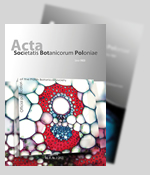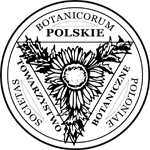Could clonality contribute to the northern survival of grey alder [Alnus incana (L.) Moench] during the Last Glacial Maximum?
Abstract
Keywords
Full Text:
PDFReferences
Bennett KD, Tzedakis PC, Willis KJ. Quaternary refugia of North European trees. J Biogeogr. 1991;18(1):103–115. https://doi.org/10.2307/2845248
Hewitt GM. Genetic consequences of climatic oscillations in the Quaternary. Philos Trans R Soc Lond B Biol Sci. 2004;359(1442):183–195. https://doi.org/10.1098/rstb.2003.1388
Willis K, van Andel T. Trees or no trees? The environments of Central and Eastern Europe during the Last Glaciation. Quat Sci Rev. 2004;23(23–24):2369–2387. https://doi.org/10.1016/j.quascirev.2004.06.002
Steward JR, Lister AM. Cryptic northern refugia and the origins of the modern biota. Trends Ecol Evol. 2001;16(11):608–613. http://dx.doi.org/10.1016/S0169-5347(01)02338-2
Bhagwat SA, Willis KJ. Species persistence in northerly glacial refugia of Europe: a matter of chance or biogeographical traits? J Biogeogr. 2008;35:464–482. https://doi.org/10.1111/j.1365-2699.2007.01861.x
Dering M, Chybicki IJ, Rączka G. Clonality as a driver of spatial genetic structure in populations of clonal tree species. J Plant Res. 2015;128(5):731–745. https://doi.org/10.1007/s10265-015-0742-7
Silvertown J. The evolutionary maintenance of sexual reproduction: evidence from the ecological distribution of asexual reproduction in clonal plants. Int J Plant Sci. 2008;169(1):157–168. https://doi.org/10.1086/523357
van der Merwe M, Spain CS, Rossetto M. Enhancing the survival and expansion potential of a founder population through clonality. New Phytol. 2010;188(3):868–878. https://doi.org/10.1111/j.1469-8137.2010.03396.x
Karlin EF, Hotchkiss SC, Boles SB, Stenøien HK, Hassel K, Flatberg KI, et al. High genetic diversity in a remote island population system: sans sex. New Phytol. 2012;193(4):1088–1097. https://doi.org/10.1111/j.1469-8137.2011.03999.x
Stöcklin J, Bäumler E. Seed rain, seedling establishment and clonal growth strategies on a glacier foreland. J Veg Sci. 1996;7(1):45–56. https://doi.org/10.2307/3236415
Öberg L, Kullman L. Ancient subalpine clonal spruces (Picea abies): sources of postglacial vegetation history in the Swedish Scandes. Arctic. 2011;64(2):183–196. https://doi.org/10.14430/arctic4098
Jalas J, Suominen J. Atlas Florae Europaeae: distribution of vascular plants in Europe Vol. 3. Salicaceae to Balanophoraceae. Helsinki: Committee for Mapping the Flora of Europe and Societas Biologica Fennica Vanario; 1976.
Kullman L. The ecological status of grey alder [Alnus incana (L.) Moench] in the upper subalpine birch forest of the central Scandes. New Phytol. 1992;120(3):445–451. https://doi.org/10.1111/j.1469-8137.1992.tb01085.x
Douda J, Doudová J, Drašnarová A, Kuneš P, Hadincová V, Krak K, et al. Migration patterns of subgenus Alnus in Europe since the Last Glacial Maximum: a systematic review. PLoS One. 2014;9(2):e88709. https://doi.org/10.1371/journal.pone.0088709
Mandák B, Havrdová A, Krak K, Hadincová V, Vít P, Zákravský P, et al. Recent similarity in distribution ranges does not mean a similar postglacial history: a phylogeographical study of the boreal tree species Alnus incana based on microsatellite and chloroplast DNA variation. New Phytol. 2016;210(4):1395–1407. https://doi.org/10.1111/nph.13848
Kulju KKM, Pekkinen M, Varvio S. Twenty-three microsatellite primer pairs for Betula pendula (Betulaceae). Mol Ecol Notes. 2004;4(3):471–473. https://doi.org/10.1111/j.1471-8286.2004.00704.x
Goudet J. FSTAT, a program to estimate and test gene diversities and fixation indices (version 2.9.3). Available from: http://www2.unil.ch/popgen/softwares/fstat.htm
Chybicki IJ, Burczyk J. Simultaneous estimation of null alleles and inbreeding coefficients. J Hered. 2009;100(1):106–113. https://doi.org/10.1093/jhered/esn088
Rousset F. genepop’007: a complete re-implementation of the genepop software for Windows and Linux. Mol Ecol Resour. 2008;8(1):103–106. https://doi.org/10.1111/j.1471-8286.2007.01931.x
Weir BS, Cockerham CC. Estimating F-statistics for the analysis of population structure. Evolution. 1984;38(6):1358–1370. https://doi.org/10.2307/2408641
Chapuis MP, Estoup A. Microsatellite null alleles and estimation of population differentiation. Mol Biol Evol. 2007;24(3):621–631. https://doi.org/10.1093/molbev/msl191
Excoffier L, Lischer HEL. Arlequin suite ver 3.5: a new series of programs to perform population genetics analyses under Linux and Windows. Mol Ecol Resour. 2010;10(3):564–567. https://doi.org/10.1111/j.1755-0998.2010.02847.x
Dorken ME, Eckert CG. Severely reduced sexual reproduction in northern populations of a clonal plant, Decodon verticillatus (Lythraceae). J Ecol. 2001;89(3):339–350. https://doi.org/10.1046/j.1365-2745.2001.00558.x
Peakall R, Smouse P. GenAlEx 6.5: genetic analysis in Excel. Population genetic software for teaching and research – an update. Bioinformatics. 2012;28(19):2537–2539. https://doi.org/10.1093/bioinformatics/bts460
Guillot G, Santos F, Estoup A. Analysing georeferenced population genetics data with Geneland: a new algorithm to deal with null alleles and a friendly graphical user interface. Bioinformatics. 2008;24(11):1406–1407. https://doi.org/10.1093/bioinformatics/btn136
Birks HH, Birks HJB. Future uses of pollen analysis must include plant macrofossils. J Biogeogr. 2000;27(1):31–35. https://doi.org/10.1046/j.1365-2699.2000.00375.x
Erdtman OGE, Berglund B, Praglowski J. An introduction to a Scandinavian pollen flora. Stockholm: Almqvist & Wiksell; 1961.
David F. Développement des aulnes dans les Alpes françaises du Nord. Comptes Rendus de l’Académie des Sciences. Série 2, Mécanique, Physique, Chimie, Sciences de l’Univers, Sciences de la Terre. 1993;316(12):1815–1822.
Binney HA, Willis KJ, Edwards ME, Bhagwat SA, Anderson PM, Andreev AA, et al. The distribution of late-Quaternary woody taxa in northern Eurasia: evidence from a new macrofossil database. Quat Sci Rev. 2009;28(23–24):2445–2464. https://doi.org/10.1016/j.quascirev.2009.04.016
Tallantire PA. The palaeohistory of the grey alder [Alnus incana (L.) Moench.] and black alder [A. glutinosa (L.) Gaertn.] in Fennoscandia. New Phytol. 1974;73(3):529–546. https://doi.org/10.1111/j.1469-8137.1974.tb02131.x
SchochW, Heller I, Schweingruber FH, Kienast F. Wood anatomy of Central European species [Internet]. 2004 [cited 2016 Dec 14]. Available from: http://www.woodanatomy.ch/
Kelly A, Charman DJ, Newnham RM. A Last Glacial Maximum pollen record from Bodmin Moor showing a possible cryptic northern refugium in southwest England. Journal of Quaternary Sciences. 2010;25(3):296–308. https://doi.org/10.1002/jqs.1309
Paus A, Velle G, Berge J. The Lateglacial and early Holocene vegetation and environment in the Dovre mountains, central Norway, as signaled in two Lateglacial nunatak lakes. Quat Sci Rev. 2011;30:1780–1796. https://doi.org/10.1016/j.quascirev.2011.04.010
Bos JAA, Huisman DJ, Kiden P, Hoek WZ, van Geel B. Early Holocene environmental change in the Kreekrak area (Zeeland, SW-Netherlands): a multi-proxy analysis. Palaeogeogr Palaeoclimatol Palaeoecol. 2005;227:259–289. https://doi.org/10.1016/j.palaeo.2005.05.020
Koff T, Kangur M. Vegetation history in northern Estonia during the Holocene based on pollen diagrams from small kettlehole and lake sediments. In: Tonkov S, editor. Aspects of palynology and palaeoecology. Festschrift in honour of Elissaveta Bozilova. Sofia: Pensoft; 2003. p. 113–126.
Kullman L. Early Holocene tree growth at a high elevation site in the northernmost Scandes of Sweden (Lapland): a palaeobiogeographical case study based on megafossil evidence. Geografiska Annaler: Series A, Physical Geography. 1999;81(1):63–74. https://doi.org/10.1111/j.0435-3676.1999.00049.x
Kullman L. Non-analogous tree flora in the Scandes Mountains, Sweden, during the early Holocene – macrofossil evidence of rapid geographic spread and response to palaeoclimate. Boreas. 1998;27(3):153–161. https://doi.org/10.1111/j.1502-3885.1998.tb00875.x
Kullman L. Boreal tree taxa in the central Scandes during the Late Glacial: implications for Late Quaternary forest history. J Biogeogr. 2002;29(9):1117–1124. https://doi.org/10.1046/j.1365-2699.2002.00743.x
Birks HH, Larsen E, Birks HJB. Did tree-Betula, Pinus and Picea survive the last glaciation along the west coast of Norway? A review of the evidence, in light of Kullman (2002). J Biogeogr. 2005;32(8):1461–1471. https://doi.org/10.1111/j.1365-2699.2005.01287.x
Kullman L. Late-glacial trees from arctic coast to alpine tundra: response to Birks et al. 2005 and 2006. J Biogeogr. 2006;33(2):377–378. https://doi.org/10.1111/j.1365-2699.2005.01451.x
Kullman L. Early postglacial appearance of tree species in northern Scandinavia: review and perspective. Quat Sci Rev. 2008;27:2467–2472. https://doi.org/10.1016/j.quascirev.2008.09.004
Birks HH, Giesecke T, Hewitt GM, Tzedakis PC, Bakke J, Birks HJB. Comment on “Glacial survival of boreal trees in northern Scandinavia”. Science. 2012;338(6108):742–742. https://doi.org/10.1126/science.1225345
Parducci L, Jørgensen T, Tollefsrud MM, Elverland E, Alm T, Fontana SL, et al. Glacial survival of boreal trees in northern Scandinavia. Science. 2012;335:1083–1086. https://doi.org/10.1126/science.1216043
Stančikaitė M, Šinkūnas P, Šeirienė V, Kisielienė D. Patterns and chronology of the Lateglacial environmental development at Pamerkiai and Kašučiai, Lithuania. Quat Sci Rev. 2008;27(1–2):127–147. https://doi.org/10.1016/j.quascirev.2007.01.014
Tzedakis PC, Emerson BC, Hewitt GM. Cryptic or mystic? Glacial tree refugia in Northern Europe. Trends Ecol Evol. 2013;28(12):696–704. https://doi.org/10.1016/j.tree.2013.09.001
Bennett KD, Tzedakis PC, Willis KJ. Quaternary refugia of north European trees. J Biogeogr. 1991;18(1):103–115. https://doi.org/10.2307/2845248
Drescher-Schneider R, de Beaulieu JL, Magny M, Walter-Simonnet AV, Bossuet G, Millet L, et al. Vegetation history, climate and human impact over the last 15 000 years at Lago dell’Accesa (Tuscany, central Italy). Veg Hist Archaeobot. 2007;16(4):279–299. https://doi.org/10.1007/s00334-006-0089-z
Hampe A, Petit RJ. Conserving biodiversity under climate change: the rear edge matters. Ecol Lett. 2005;8(5):461–467. https://doi.org/10.1111/j.1461-0248.2005.00739.x
Jankowská V, Chromy P, Nižnianská M. Šafárka – first palaeobotanical data of the character of Last Glacial vegetation and landscape in the West Carpathians (Slovakia). Acta Palaeobotanica. 2002;42(1):39–50.
Stachowicz-Rybka R, Galka M, Alexandrowicz WP, Alexandrowicz SW. Plant macrofossils and malacocoenoses of Quaternary mineral-organic sediments at Starunia palaeontological site and vicinity (Carpathian Region, Ukraine). Annales Societatis Geologorum Poloniae. 2009;79(3):297–313.
Liepelt S, Cheddadi R, de Beaulieu JL, Fady B, Gömöry D, Hussendörfer E, et al. Postglacial range expansion and its genetic imprints in Abies alba (Mill.) – a synthesis from palaeobotanic and genetic data. Rev Palaeobot Palynol. 2009;153(1–2):139–149. https://doi.org/10.1016/j.revpalbo.2008.07.007
Boratynska K, Muchewicz E, Drojma M. Pinus mugo Turra geographic differentiation based on needle characters. Dendrobiology. 2004;(51):9–17.
Dzialuk A, Boratynski A, Boratynska K, Burczyk J. Geographic patterns of genetic diversity of Pinus mugo (Pinaceae) in Central European mountains. Dendrobiology. 2012;68:31–41.
Cheddadi R, Vendramin GG, Litt T, François L, Kageyama M, Lorentz S, et al. Imprints of glacial refugia in the modern genetic diversity of Pinus sylvestris. Global Ecology and Biogeography. 2006;15(3):271–282. https://doi.org/10.1111/j.1466-8238.2006.00226.x
Heuertz M, Teufel J, González-Martínez SC, Soto A, Fady B, Alía R, et al. Geography determines genetic relationships between species of mountain pine (Pinus mugo complex) in Western Europe. J Biogeogr. 2010;37(3):541–556. https://doi.org/10.1111/j.1365-2699.2009.02223.x
Ortu E, David F, Peyron O. Pollen-inferred palaeoclimate reconstruction in the Alps during the Lateglacial and the early Holocene: how to estimate the effect of elevation and local parameters. J Quat Sci. 2010;25(5):651–661. https://doi.org/10.1002/jqs.1335
Honnay O, Bossuyt B. Prolonged clonal growth: escape route or route to extinction? Oikos. 2005;108(2):427–432. https://doi.org/10.1111/j.0030-1299.2005.13569.x
Balloux F, Lehmann L, de Meeûs T. The population genetics of clonal and partially clonal diploids. Genetics. 2003;164(4):1635–1644.
Zhuk A, Veinberga I, Daugavietis M, Ruņgis. Cross-species amplification of Betula pendula Roth. simple sequence repeat markers in Alnus species. Balt For. 2008;14(2):116–121.
Wang P, Lei JP, Li MH, Yu FH. Spatial heterogeneity in light supply affects intraspecific competition of a stoloniferous clonal plant. PLoS One. 2012;7(6):e39105. https://doi.org/10.1371/journal.pone.0039105
Hartnett DC, Bazzaz FA. The genet and ramet population dynamics of Solidago canadensis in an abandoned field. J Ecol. 1985:73:407–413. https://doi.org/10.2307/2260483
Vandepitte K, Roldán-Ruiz I, Leus L, Jacquemyn H, Honnay O. Canopy closure shapes clonal diversity and fine-scale genetic structure in the dioecious understory perennial Mercurialis perennis. J Ecol. 2009;97:404–414. https://doi.org/10.1111/j.1365-2745.2009.01484.x
DOI: https://doi.org/10.5586/asbp.3523
|
|
|








